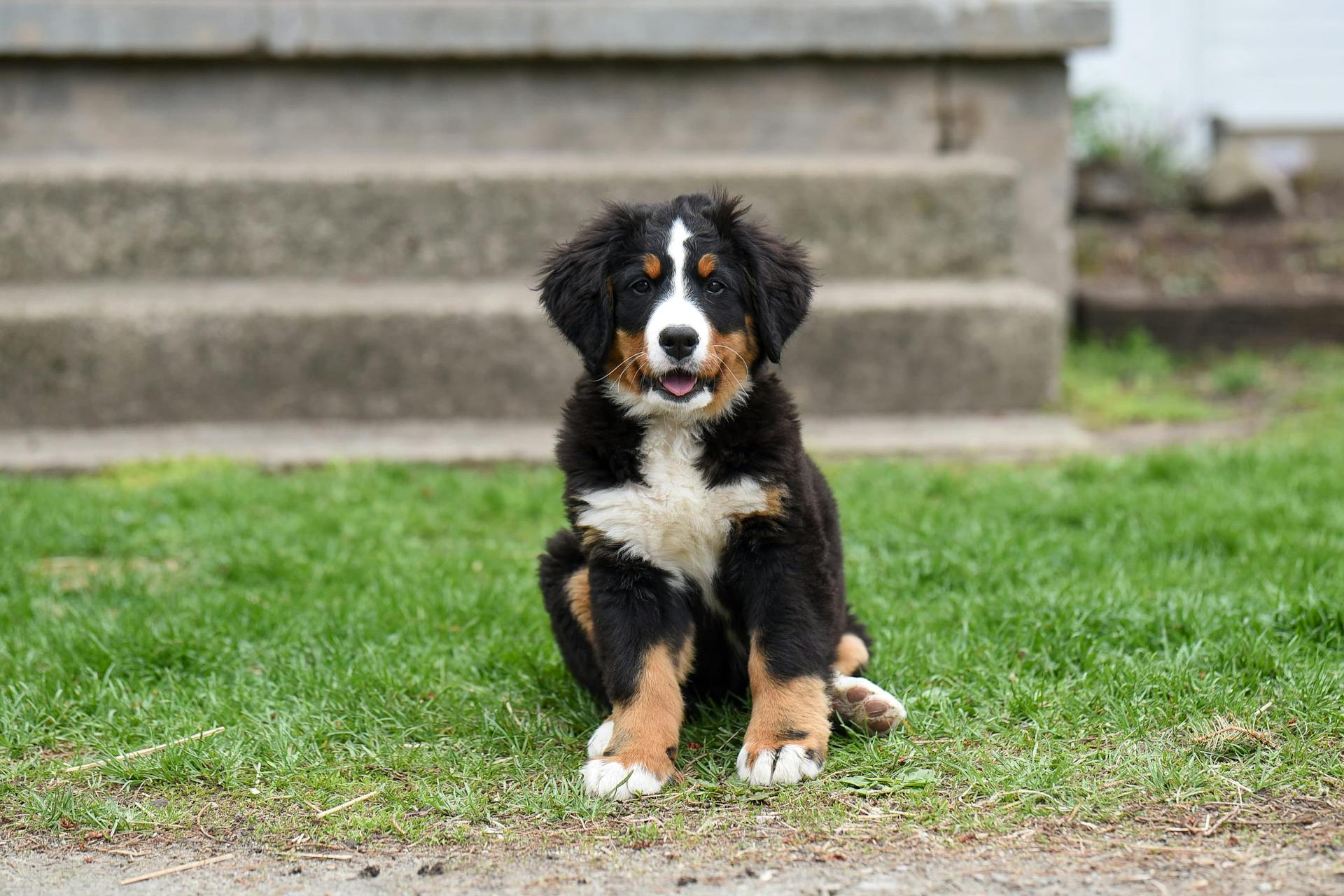
If you're considering bringing a Bernese Mountain Dog and a cat into your family, it's essential to understand their unique needs and personalities.
Bernese Mountain Dogs are gentle giants, known for their calm and patient nature, which makes them a great match for families with cats.
However, as with any large breed dog, they do require regular exercise and mental stimulation to prevent boredom and destructive behavior.
A daily walk of at least 30 minutes is recommended to keep your Bernese Mountain Dog happy and healthy.
Bernese Mountain Dog Basics
The Bernese Mountain Dog is a gentle giant, typically standing between 23 and 27.5 inches tall.
Their thick, medium-length double coat requires regular grooming to prevent matting and tangling. This breed can weigh anywhere from 70 to 115 pounds, making them a substantial addition to any family.
Their lifespan is relatively short, ranging from 7 to 10 years, so it's essential to cherish the time you have with them.
Breed Overview
The Bernese Mountain Dog is a majestic breed with a sturdy build. They typically stand between 23 to 26 inches tall, with females being on the shorter end of that range.
Their weight can vary, but you can expect females to weigh between 70 to 95 pounds, while males tend to be a bit heavier, weighing between 80 to 115 pounds.
Their thick, medium-length double coat requires regular grooming to prevent matting and tangling. It comes in a variety of colors, including black, rust, and white, or black, tan, and white.
Despite their large size, Bernese Mountain Dogs are known for being gentle and even-tempered, making them a great addition to families. They're also extremely loyal, always happy to be by your side.
Originating from Switzerland, this breed has a long history of being a working dog, used for tasks such as herding and drafting.
The History of Dogs
The Bernese Mountain Dog has a rich history that spans thousands of years. They originated in and around the Swiss city of Berne, with genetic ties to the Roman mastiff.
Their ancestors were used by dairy farmers to pull carts, herd animals, and serve as guard dogs. These tasks required strength and intelligence, which the Bernese Mountain Dogs possessed in abundance.
The breed's popularity waned with the modernization of farms, but breed enthusiasts stepped in to save the day. Professor Albert Heim, a renowned European dog expert, created the first breeding club for the Bernese Mountain Dog.
In 1926, two Berner pups were welcomed into a Kansas farm, marking the breed's debut in America. Their popularity grew quickly from there.
The American Kennel Club officially recognized the Bernese Mountain Dog breed over a decade later, in 1937.
Dog Characteristics and Care
Bernese Mountain Dogs are known for their gentle nature and eagerness to please, making them excellent house dogs. They're highly trainable, and with proper socialization, they can be open to meeting strangers and are quite affectionate with their families.
Their intelligence and trainability make them a joy to work with, but their size means they can accidentally knock over a child or adult if they get too energetic. They're not the right breed for you if you work long hours and expect a dog who can remain happily alone at home.
Here are some key characteristics of Bernese Mountain Dogs at a glance:
Dog Characteristics
Bernese Mountain Dogs are known for their gentle nature and eagerness to please, making them excellent house dogs. They thrive on attention and affection from their families, and can become destructive if left alone for too long.
These intelligent dogs are highly trainable, but require thorough obedience training in puppyhood to prevent unwanted behaviors. With consistent training, they can excel in various dog sports and activities.
One of the most distinctive characteristics of Bernese Mountain Dogs is their thick coat, which sheds heavily and requires regular grooming. This makes them a great choice for outdoor enthusiasts who live in cold climates, but may not be ideal for those with allergies or a preference for low-maintenance grooming.
In terms of exercise, Bernese Mountain Dogs need regular physical activity to stay happy and healthy. They require at least a medium level of exercise, which can be achieved through daily walks, playtime, and outdoor activities.
On a similar theme: Bernese Mountain Dog Exercise
Here's a summary of the key characteristics of Bernese Mountain Dogs:
Bernese Mountain Dogs are generally gentle with children, making them a great option for families with younger kids. However, their large size and energetic nature can make them a challenge to manage, especially for new dog owners or elderly people.
Physical Attributes
The Bernese mountain dog is a large breed, with males typically growing between 25 to 27 ½ inches and females growing between 23 to 26 inches at full size.
Their weight can vary, but they usually range from 70 to 115 pounds, depending on their diet and exercise level.
These dogs have a beautiful, silky, tri-colored coat of black, white, and rust with distinctive markings and dark eyes.
Their long, thick hair results in very high amounts of shedding, so consistent grooming and maintenance are a must to manage the shedding.
You'll likely find some dog hair throughout your home and on your belongings, and those with allergies to dog hair should consider looking into alternatives.
Be prepared for some slobber, as Bernese mountain dogs are predisposed to drooling, and you may find yourself wiping their face every once in a while.
For more insights, see: Shedding Bernese Mountain Dog
Diet and Nutrition
Fresh water should always be available for your Bernese Mountain dog, and selecting a quality, nutritionally balanced canine diet is essential. This is especially crucial for Berner puppies, which require a diet made for large breeds to prevent joint problems and other issues.
Feeding your dog twice a day is a common practice, but it's essential to discuss the diet and quantity with your veterinarian to ensure your dog is eating properly. They can help you determine the best feeding schedule for your dog.
Using slow feeder bowls instead of elevated bowls can help prevent bloat, which is a significant risk for large breed dogs like Bernese Mountain dogs.
Consider reading: Bernese Mountain Dog Puppy Feeding Chart
Pet Compatibility
Bernese Mountain Dogs are naturally relaxed around other pets, including cats, dogs, and farm animals. They're not inclined to cause conflict or chase small animals.
These gentle giants are ideal family pets, rarely aggressive and patient with small children. They can handle roughhousing, but it's essential to teach kids to treat them gently.
Explore further: Breeds of Small White Dogs
Supervise interactions between Bernese Mountain Dogs and other pets, especially when introducing a new furry friend to the household. This will help you understand their temperaments and ensure a harmonious household.
If you have other pets, like dogs or cats, Bernese Mountain Dogs are unlikely to act aggressively towards them. However, they may enjoy chasing small mammals, like squirrels or raccoons.
Owning a Bernese Mountain Dog
If you're considering bringing a Bernese Mountain Dog into your home, you'll want to know that they have a good-natured personality, making them excellent house dogs.
Their gentle nature and eagerness to please mean they thrive on attention and affection from their family, and they're quite trainable, too. With proper socialization, they can be open to meeting strangers and are quite affectionate with their families.
However, Bernese Mountain Dogs don't like to be left alone for too long, so they're not the best fit for busy owners who work long hours. They require regular interaction and exercise to stay happy and healthy.
Dog Safety with Kids
When introducing a Bernese Mountain Dog to your family, it's essential to teach your young children to treat the dog gently and supervise interactions between them.
Bernese Mountain Dogs are rarely, if ever, aggressive, making them ideal family pets. They have plenty of energy and patience around small children.
Roughhousing is a natural part of childhood, but it's crucial to teach your kids to be gentle with your Berner. This will help prevent accidental injuries to both the child and the dog.
Bernese Mountain Dogs can handle their fair share of roughhousing due to their robust nature, but it's still important to supervise interactions between children and dogs.
Owning a Dog
Owning a dog is a big responsibility, and it's essential to consider the costs involved. You can expect to spend around $1,000 to $2,000 per year on food, vet bills, and other expenses.
Bernese Mountain Dogs are large dogs, so they need plenty of space to move around. A house with a big yard is ideal, but a small yard or even an apartment can work if you're willing to take them on regular walks.
Their thick coats require regular grooming to prevent matting and tangling. Brushing them daily can help prevent these problems and keep them looking their best.
Bernese Mountain Dogs are intelligent and trainable, but they can be stubborn at times. Consistent training and positive reinforcement are key to developing good behavior.
Their calm and gentle nature makes them great family pets, but they can be wary of strangers and may take time to warm up to new people.
Frequently Asked Questions
How to introduce a dog to a cat?
To introduce a dog to a cat safely, start by providing a dog-free sanctuary for the cat and gradually introduce them in a controlled environment, beginning with basic commands and face-to-face meetings. Follow a step-by-step process to ensure a smooth and stress-free introduction.
Featured Images: pexels.com


